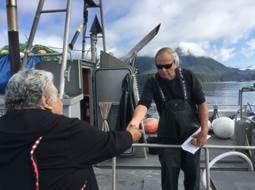Gwa’sala-‘Nakwaxda’xw Nation representatives were in Smith Inlet this morning (July 15) protesting the opening of a commercial sockeye fishery by the Department of Fisheries and Oceans (DFO).
Wayne Walkus hoisted a traditional salmon above his head, demonstrating his aboriginal right to fish in his local territory, while e DFO aircraft attempted to fly over the fishing vessel more than a few times, each time at a lower altitude.
The fishery is located in Smith Inlet on British Columbia’s central coast. DFO had previously stated that a fishery wouldn’t open until a minimum count of 100,000 salmon passed through a counting fence located at Docee Creek.
According to the DFO website that milestone was reached this year as 105,333 sockeye were counted from July 1 to July 13.That is an increase from a two-month total of 104,949 in 2015 and 96,617 in 2014.The Docee River counting fence has been in operation since 1972.
A counting tower was in operation from 1962 to 1971. Daily sockeye information recorded at the fence is used for the management of the commercial gillnet fishery in Smith Inlet. The counting fence generally operates from late June or early July to mid August.Sockeye are sampled from the fence for post orbital to hypural plate length and tip of nose to the fork of the tail length. Scales are taken from each fish for age determination.
